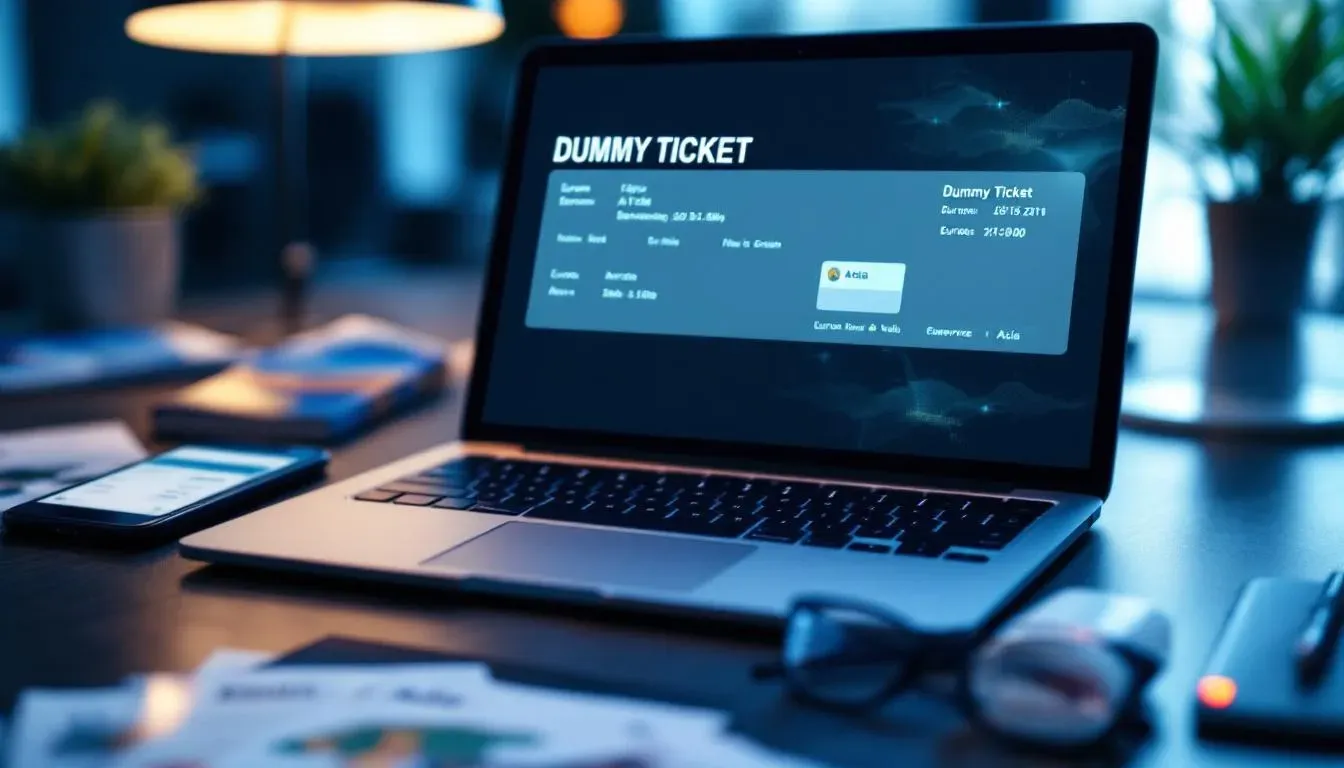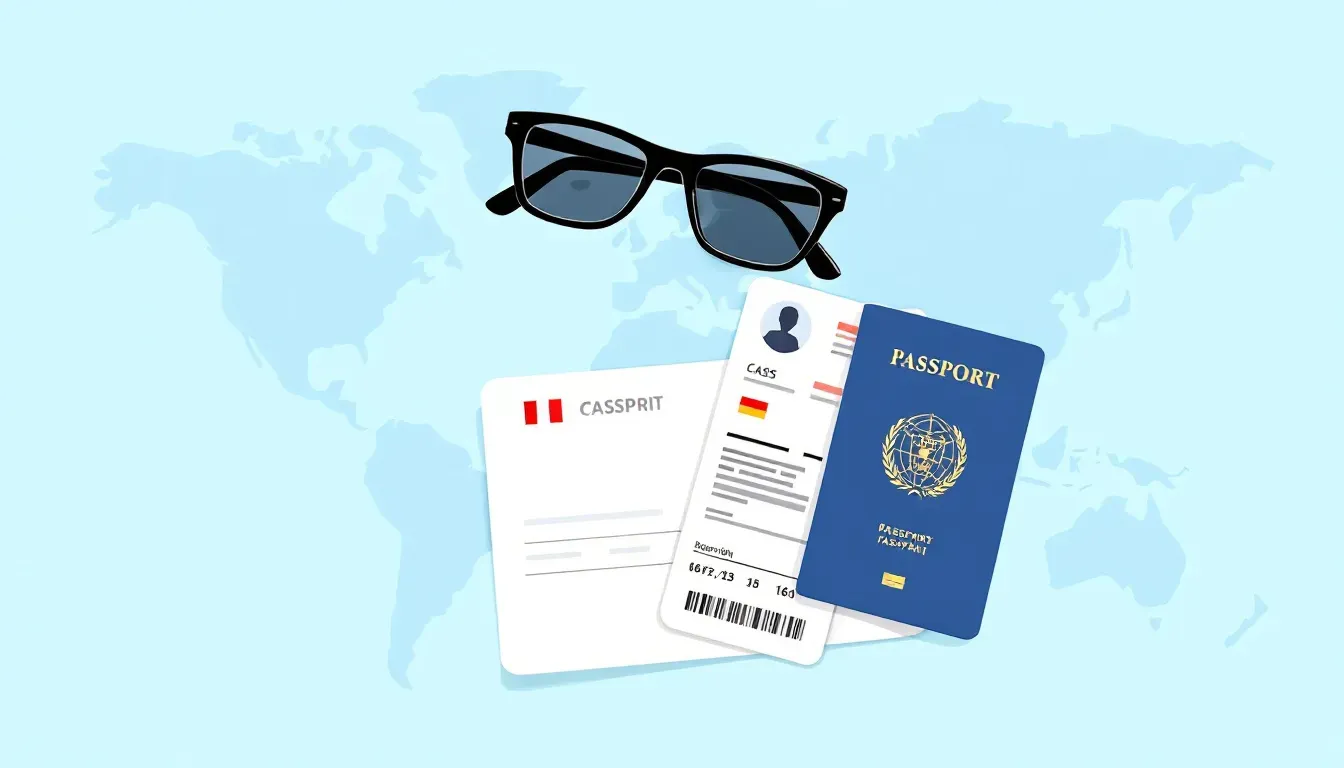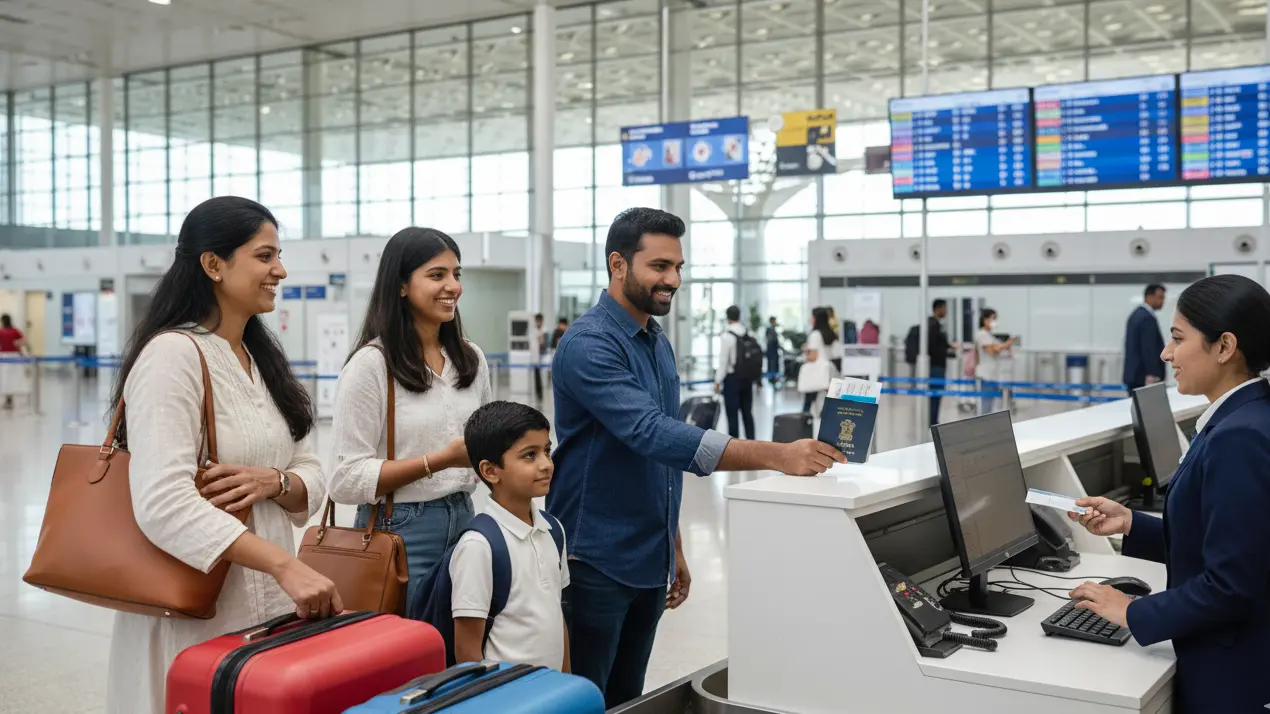Will a Flight Reservation Be Enough for Your Maldives Visa? Here’s the Truth
For Indian travelers seeking a seamless Maldives getaway, securing a dummy ticket is often the smart first step. It provides verifiable proof of onward travel without locking in non-refundable fares. Your return plan, hotel dates, and transfers must tell one clear story. Whether you're planning a honeymoon or family escape, a dummy ticket ensures flexibility while meeting visa requirements.
We’ll walk you through what really gets accepted and why. We’ll map the three gatekeepers you meet on this journey: the online application or consulate, the airline at check-in, and the Maldives immigration on arrival. You’ll see how each reads your paperwork, when a reservation works, when a paid ticket helps, and how to stay flexible without risking your trip or your money. For more tips on visa prep, check our FAQ or dive into our blogs. Kickstart your visa file in minutes—try dummy ticket booking and get a verifiable PNR instantly. Learn about our team's expertise on the About Us page.
Yes — a flight reservation is fully accepted for Maldives visa on arrival, as long as it shows your confirmed entry flight and a planned return or onward ticket. Maldives immigration officers only need proof that you will leave the country within the permitted stay period, and a verifiable reservation is enough to demonstrate this intent. You do not need to buy an expensive, non-refundable airline ticket before traveling. Platforms like BookForVisa.com provide embassy and immigration-compliant flight reservations with real airline data and verifiable itineraries, making your arrival process smooth, safe, and risk-free.
Last updated: November 2025 — verified with current Maldives Immigration entry guidelines.
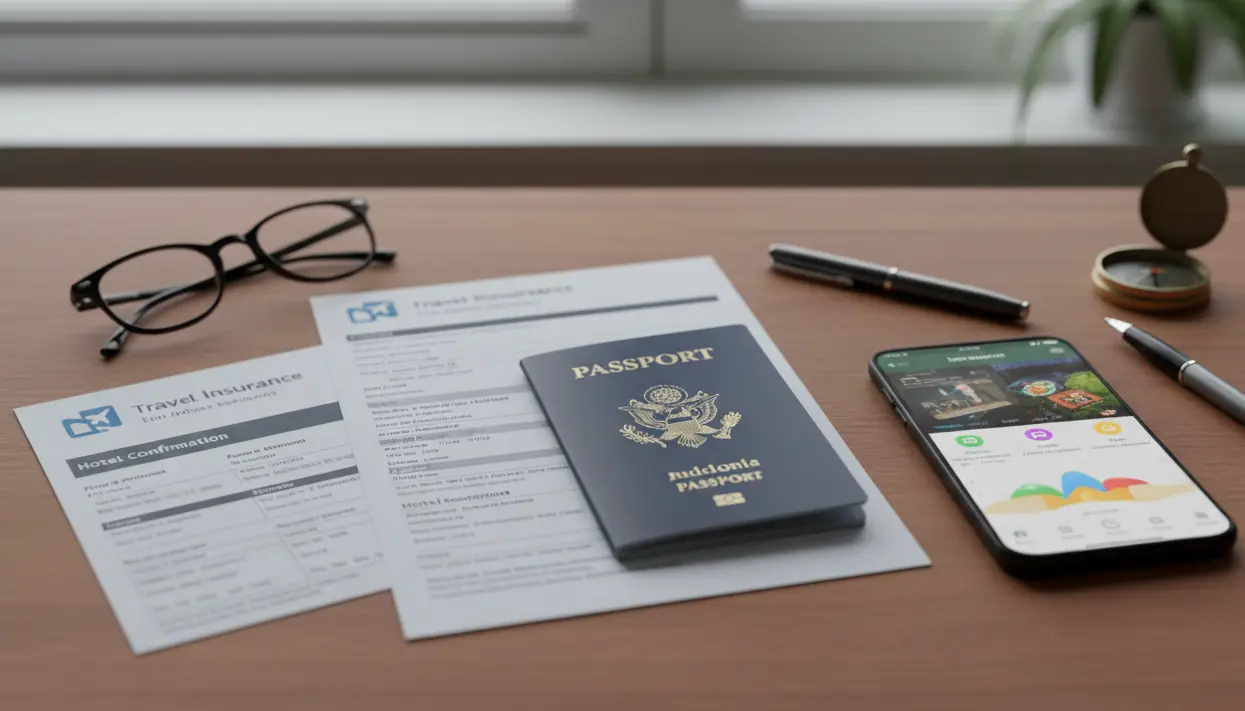
Where Flight Reservations Actually Stand For Maldives Trips From India
You already know the difference between a reservation and a paid ticket. What you need is clarity on acceptance. For Maldives travel, that answer depends on who is reading your papers and at what stage of the journey. We’ll break it down so you can move from guesswork to a clean, repeatable plan that works in Indian travel realities. Need flexible dates that still pass checks? Secure your spot now and book a dummy ticket.
Acceptance Is Contextual, Not Absolute
A reservation can be enough. It must prove a credible plan to leave within your allowed stay. Different checkpoints read that proof differently.
- Application portals and consulates aim for sufficiency. If the checklist asks for proof of onward travel, a clear reservation generally answers it for a Maldives tourist visa file or a short holiday under basic entry requirements.
- Airline check-in focuses on risk. Carriers use Timatic rules and internal policies to avoid fines. They look for evidence that you can enter and will exit on time with return journey confirmed tickets that align with your stay.
- Maldives immigration checks practicality. Officers want a consistent story across dates, resort transfers, sufficient funds, and a valid passport with sensible passport validity.
Think of acceptance as a triangle. If your documents align, you do not need to overpay for non-refundable tickets. If something in the triangle is weak, you compensate with stronger proof.
Why Indian Travelers Still Get Asked For Papers Despite Visa On Arrival
Visa on arrival is common for indian nationals. That does not mean “no documents.” The scrutiny often shifts to airline counters in India and to basic checks on arrival. The pattern is predictable during school holidays, long weekends, and sale fare waves.
Where you might be asked to show flight proof:
- Mixed itineraries like India–Malé–Colombo–India with clear onward destinations.
- Split resort and guesthouse stays where transfer windows must line up with flights and a confirmed hotel booking.
- Corporate trips with late approvals and shifting dates, sometimes overlapping with a business visa purpose elsewhere.
- Last-minute deals where your insurance and hotel confirmations lag behind your flight hold and complete travel itinerary.
- Group travel with multiple PNRs that do not match the same return date, including a traveler under a dependent visa or with dependent status.
The cure is consistency. Your papers should remove doubts in under a minute.
What Reviewers Actually Look For When They Say “Proof Of Onward Travel”
We see the same checklist expectations repeat. Keep these aligned, and you rarely face pushback.
- Return timing that fits the permitted stay, often up to 90 days for a leisure trip. Do not push to the very last day if your resort transfer ends a day earlier.
- One storyline across documents. Your flight dates match resort nights, transfer slots, and insurance validity for the stay in the Maldives.
- Routing that makes sense from India. Delhi, Mumbai, Bengaluru, Chennai, and Hyderabad to Malé are common. Via Colombo, Doha, or Abu Dhabi is fine if the connection is reasonable for a foreigner travelling from India.
- Financial credibility. Bank statements or a card limit that covers the stay. If a sponsor is involved, the letter and payment trail must match the names on the bookings and the same passport used at check-in.
- Contactable bookings. Resort confirmations for a registered hotel that include transfer details, guest names, and dates help officers connect the dots quickly.
When the narrative is clean, the format of “reservation vs ticket” matters less than you think. For global standards on travel documentation, see the IATA guidelines.
The Practical Difference Between Reservation, Ticket, And Flexible Fare For Maldives Files
You do not need the textbook definitions. You need the playbook.
- Reservation holds buy you time. They are ideal when your VFS slot or internal approvals are within a week or two. They work when the portal asks for proof rather than payment, especially for tourist visa travel submitted electronically alongside a simple application form.
- Fully issued tickets make sense if you are traveling within days, have found a price you would buy anyway, or if a specific officer insists on paid evidence upon arrival checks.
- Flexible or refundable fares are the pressure valve. They carry higher base prices but can be refunded or changed with less pain. Read the rules carefully because “refundable” can still include hefty fees, which matters if your prepaid confirmed booking shifts.
Your choice is not permanent. Start with a reservation to align all documents. Convert to a paid or flexible ticket only when timing or an officer’s instruction demands it.
Three Gatekeepers. Three Thresholds. One Standard You Can Meet.
Let us translate the thresholds into action.
Embassy or Online Application
- Aim for legibility. One PDF packet that shows flight reservation first, resort confirmation next, and insurance last, plus any following documents required by local visa requirements.
- Add a simple itinerary note if your routing is not direct, and provide proof of your financial means.
- If you combine the Maldives with another country, mention that status briefly so the onward segment still looks credible for transit travellers or a foreign national with side trips.
Airline Check-In In India
- Agents rely on Timatic. They check your entry permission and onward proof to enter the Maldives and to travel as a foreigner, travelling with a valid travel document.
- A reservation with a visible PNR and dates synced to your resort transfer usually passes in seconds while traveling to the Maldives.
- Present the packet on your phone and carry printed copies. A neat layout communicates that you prepared for this and that your journey confirmed tickets align with your hotel dates.
Maldives Immigration On Arrival
- Officers may ask for onward travel and accommodation details under the spirit of the maldives immigration act. A prepaid confirmed hotel booking helps.
- If you have a seaplane or speedboat transfer letter with timing, it supports your return flight date and smooth immigration clearance.
- Keep a card statement or modest cash proof if you are doing a guesthouse stay without prepaid invoices, especially if asked by immigration officers during clearing Maldives arrival immigration.
Build your documents to satisfy all three, not just one.
India-Specific Scenarios That Usually Work Without Paying Upfront
These are common plans we see, with reasons they pass the sniff test.
Honeymoon With Resort Seaplane Transfer
- Round-trip reservation from Mumbai to Malé for seven nights with confirmed return journey tickets timed to transfers.
- Resort confirmation shows names, nights, board basis, and seaplane timing that matches your inbound arrival window, plus a prepaid confirmed hotel booking line.
- Insurance covers full stay plus a two-day buffer.
- The story is complete and believable for foreigners arriving as a couple with an own passport each.
Budget Combo: Malé With A Colombo Stop
- India to Colombo reservation, Colombo to Malé reservation, then Malé to India return, all tied to a complete travel itinerary.
- Guesthouse bookings show first and last nights in Malé with a mid-trip island stay and a confirmed hotel booking.
- Insurance covers the entire period across both countries.
- A short note in your packet clarifies the sequence so the onward segment is obvious upon arrival.
Family Trip During School Holidays
- Return reservation for ten days from Delhi to Malé with journey confirmed tickets on a single PNR.
- Resort confirms inter-island transfers sized for four passengers.
- A second, parallel hold with a one-day earlier return exists as backup during fare volatility, but you present only the active one in your packet.
- Funds proof is combined household banking, which is acceptable if names match tickets and bookings and the validity in their passports is clear.
Business Visa Traveler With Late Approvals
- Reservation reflects tentative dates.
- The company letter states the purpose, cost coverage, and tentative return within the permitted window, which differs from a work visa or valid work permit case that may require pre-approval.
- Insurance is corporate or individual, with matching dates.
- If approvals slip, you refresh the reservation while keeping the same routing and time bands to keep onward destinations unchanged.
Red Flags That Trigger Questions And How You Avoid Them
You can spot them before an agent does.
- Mismatched dates. Flight returns after insurance ends or after resort checkout. Fix by extending insurance or adjusting the hold.
- Onward flight to a country you cannot enter. Return to India or a country where you are clearly admissible; some Israeli passports or other categories may face additional policies that do not guarantee entry.
- Multiple passengers with different return dates. Align the group or explain clearly with two distinct packets tied to the same passport details.
- Name mismatches and typos. Correct before submission. Even a minor error in the machine-readable zone can derail a quick check.
- Unrealistic connections. If the routing requires a visa or an impossible transfer time, choose a cleaner path.
When you remove these red flags, agents have no reason to escalate.
How To Present Your Papers So They Get Accepted Faster
A good presentation is a quiet superpower at counters and windows in India.
- One-file rule. Merge flight reservation, accommodation, transfers, and insurance into a single PDF in that order, plus any traveller declaration if it must be filled electronically.
- Clear filenames. Use Surname_MLE_TripDocs_YYYY-MM-DD.pdf so you always show the latest.
- Visible PNR and dates. Make sure the key fields appear on page one for immigration clearance upon arrival.
- Short cover note. Two lines that explain your routing if it is not direct.
- Printed copy for backups. Phones die. Printers at airports are not reliable.
You are not trying to overwhelm anyone. You are aiming for zero doubt in under a minute.
What To Do If Someone Still Asks For A Paid Ticket
Do not panic. You have options.
- Ask whether a reservation with a verifiable PNR is sufficient, especially when passengers with an extended trip only need proof for the maximum duration allowed.
- If the answer is a firm no, switch to a flexible or refundable fare that you are comfortable holding while travelling to the Maldives.
- Keep the same routing and times if possible so your resort transfer and insurance remain aligned with your pre-period plan.
- Update the packet quickly and keep proof of the earlier reservation as context.
The goal is to solve the request without creating new inconsistencies.
A Simple Flow That Works For Most Indian Travelers
You can reuse this across seasons.
- Create a reservation on the routing and times that match your resort transfer windows and registered hotel check-in.
- Secure accommodation with clear names and dates. Get the seaplane or speedboat time in writing and any traveller declaration submitted electronically within 96 hours, if applicable, on a digital platform.
- Buy insurance that covers the entire window plus a small buffer, and carry a yellow fever vaccination certificate if you have visited yellow fever-endemic countries.
- Merge a single PDF and submit to the portal or carry it to your appointment alongside the following documents, like a marriage certificate for a spouse on a marriage visa or pre-approved sponsorship visa cases.
- Refresh the reservation within 48 to 72 hours of submission or departure if your hold window is short, keeping your travel document and your own passport details identical.
- Keep an eye on fare drops. Convert to a paid ticket only when your plan is locked; remember, tickets alone do not guarantee entry for any foreign national or Maldivian national relative.
A flight reservation is commonly accepted for Maldives trip files when the requirement is “proof of onward travel.” What wins acceptance is not the payment status. It is the coherence of your story. Align dates across flights, resort transfers, and insurance. Use India-sensible routings. Present a tidy packet. Handle red flags before someone else spots them. Follow this structure, and you will keep your flexibility while clearing the Maldives arrival immigration with confidence and a smooth stay in the Maldives.
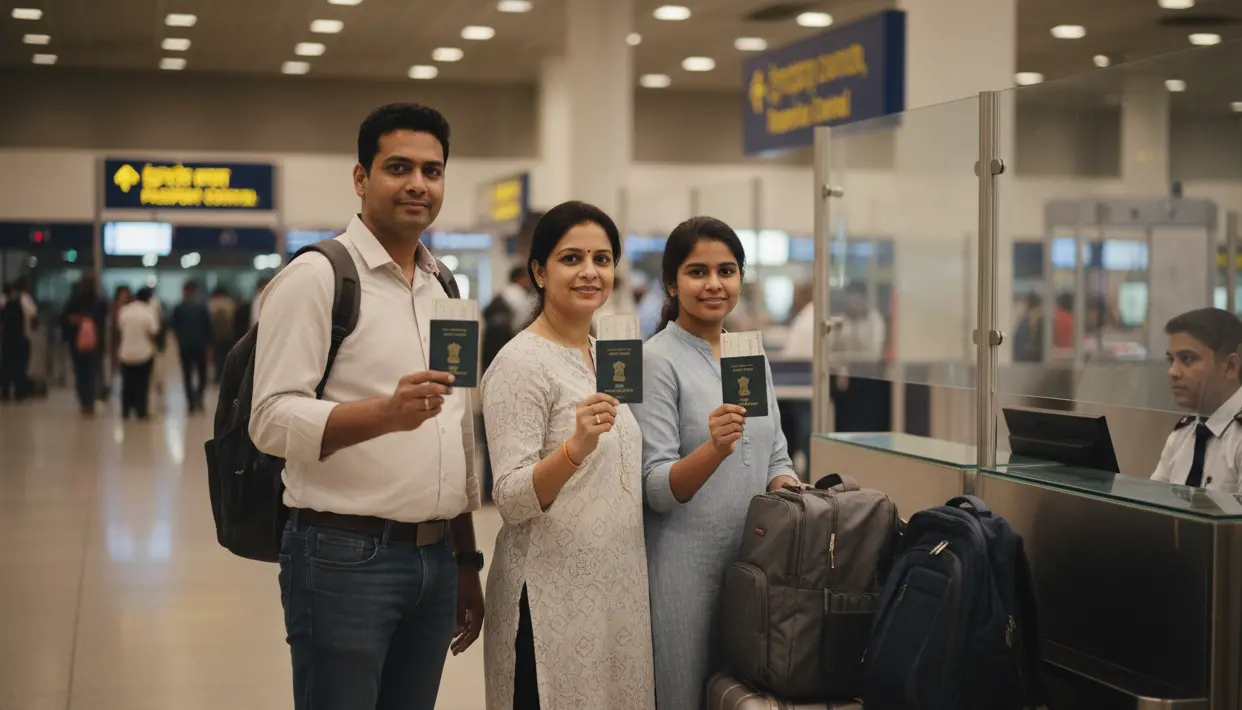
Reservations, Paid Tickets, Or Flexible Fares: What Actually Works In Your Maldives Tourist Visa File
You do not need a lecture. You need a plan that fits real Indian timelines and still clears scrutiny. Let’s map how each option behaves once your file meets an officer, a VFS desk, or an airline counter. We will compare cost, control, and compliance so you can choose with confidence. Keep your costs low while you finalize plans with a fast, reliable dummy ticket booking. 👉 Order your dummy ticket today for instant peace of mind.
Start With The Goal, Not The Document Type
The goal is simple. You need credible proof that you will exit the Maldives within your permitted stay and that your dates match your hotel and transfers. Once you frame it this way, the question becomes tactical. Which tool gives you the cleanest proof at the lowest risk for your specific week, routing, and appointment date in India?
Flight Reservations: The Smart Hold That Buys You Time
A good reservation does three things for you. It shows clear dates. It prints cleanly with a visible PNR. It holds long enough to get through your submission window.
Use reservations when:
- Your appointment is soon, but not immediate. You have 3 to 14 days to go.
- Your resort transfer times are locked. You need your flights to show matching arrival and departure windows.
- Your leave is pending. You want proof now without funding a non-refundable fare.
How to set reservations up for success:
- Match names and dates exactly. This sounds basic, but it prevents 90 percent of questions.
- Aim for realistic routing. DEL or BOM to MLE direct, or via CMB, DOH, or AUH with legal connections.
- Refresh before deadlines. If your hold expires in 48 hours, regenerate it 24 hours before your submission or travel day so your print shows a fresh timestamp.
- Keep versions. Save v1, v2, v3 with datestamps so you can show history if asked.
Where reservations struggle:
- Very short validity windows. A 24 to 48-hour hold can expire mid-review if you submit near a public holiday in India.
- Agents who ask for “paid” proof. Rare but possible. We cover your response later in this section.
Fully Issued Tickets: Certainty At A Price
A paid ticket moves the conversation from intent to commitment. That can be useful, but it shifts the risk to your wallet.
When a paid ticket makes sense:
- You fly within days. There is no buffer to play the reservation refresh game.
- You found a price you would buy anyway. A sharp round-trip sale from BLR or MAA that fits your dates.
- A reviewer explicitly requested it. You tried with a reservation and got a clear instruction to show an issued ticket.
What to watch out for in India:
- Refund timelines. International refunds can take weeks to hit your card. Plan cash flow accordingly.
- Fare family rules. Basic economy rules can be unforgiving, even if the site shows “refunds available.”
- FX and fee leakage. You may pay conversion and service fees on purchase and again on refund.
- Name corrections. Paid tickets are harder to fix if your passport has a spacing or middle-name quirk.
Best practices if you go paid:
- Document everything. Keep the fare rules PDF and receipt in your packet.
- Lock the rest of the story. Ensure the resort and insurance already match, so you do not chase changes after purchase.
Flexible Or Refundable Fares: Freedom With Footnotes
Flexible fares look like the perfect middle ground. In practice, they are great when you need the strength of a paid ticket but want a clear exit route if plans move.
When flexible fares work:
- Corporate travelers with shifting meetings. Finance is willing to support higher fares for schedule control.
- Peak school holidays. You need seats on a specific time band from DEL or BOM and expect timing risk.
- Multi-country itineraries. You might reshuffle a Colombo side trip depending on approvals or availability.
What to verify before you buy:
- True refundability. Is it a full refund to the original form of payment or a future credit with penalties?
- Change windows. Is there a free change before departure or only after a fee?
- No-shows. Missing a flight can void the flexibility benefit.
- Separate PNR segments. If your India–hub leg and hub–MLE leg are separate, you may pay change fees twice.
How to use flexibility wisely:
- Mirror your resort and transfer slots. Keep times similar when you change so the rest of your packet still aligns.
- Record each change. Save updated e-ticket receipts. Add a two-line note at the top of your PDF packet documenting the current final plan.
Reading The Fine Print In “Proof Of Travel” Checklists
Most checklists say “proof of onward travel.” They often do not insist on a paid ticket. The burden is on you to make your proof look complete, current, and consistent.
What officers expect to see:
- A credible return within the permitted stay. Avoid last-minute returns if your hotel checks you out earlier.
- Matching accommodation and transfer details. Seaplane windows that fit flight times.
- Insurance that covers the full period. Add a two-day buffer for weather or reschedules.
- Passenger counts aligned. If two adults and one child are on the resort invoice, the flights should show three passengers too.
How to handle ambiguous wording:
- Attach a clear reservation with a live PNR. Add a note: “Return to India within permitted stay. Dates match accommodation.”
- If a reviewer still asks for paid proof. Shift to a flexible fare that preserves your routing and times. Update your PDFs the same day.
The Cost–Control–Compliance Matrix You Can Reuse
Pick the column that fits your week. Adjust if conditions change.
- Reservations
- Cost: Lowest today.
- Control: High if you refresh the validity.
- Compliance: Strong when dates match hotel and insurance.
- Use When: You need proof now and flexibility later.
- Paid Non-Refundable
- Cost: Low fare now, high risk later.
- Control: Low if plans move.
- Compliance: Very strong.
- Use When: Travel is imminent or the price is a keeper.
- Flexible/Refundable
- Cost: Highest sticker price.
- Control: Strongest for shifting plans.
- Compliance: Very strong.
- Use When: Corporate coverage or volatile timing.
Keep Your Paper Trail Tight And Boring
Officers love tidy files. Airline counters move faster when your story is obvious. Build these habits, and you reduce questions.
- One master PDF. Flights first, then hotel, then transfers, then insurance.
- Short preface. Two lines that explain any connection or side trip.
- Visible timestamps. Your reservation should show a current creation date or last update.
- Version tags. Label v2 or v3 in the filename so you never present the wrong copy.
- Email-ready format. Keep a small file size so you can forward it quickly if asked.
What To Do If A Counter Agent Pushes Back On A Reservation
It happens. Stay calm and solution-focused.
- Offer verification. Ask the agent to check the PNR. Keep the booking source at hand in case they need contact.
- Show alignment. Point to resort seaplane timing that depends on the same flight times.
- Present funds proof. A recent statement or card limit screenshot can close the loop.
- Escalate only if needed. If the agent is firm about a paid ticket, step aside, purchase a flexible fare that mirrors your reservation, and return with updated proofs.
When A Verifiable Reservation Solves Real Problems
If you need a reservation that prints cleanly, verifies through a live PNR, and updates quickly when dates shift, use a service that is built for visa files. BookForVisa.com provides instantly deliverable reservations with a verifiable PNR, unlimited date changes, and transparent pricing at $15 (≈₹1,300). It is a tactical fix when your VFS slot is soon, your resort transfer is already locked, and you want proof that aligns without committing to a non-refundable fare.
India-Focused Scenarios And The Best Tool For Each
Weekend Sprint From Bengaluru
- You plan a Friday night departure and a Monday return.
- Use a reservation first to nail the exact seaplane slot.
- Convert to a paid ticket 48 hours before departure if the fare is stable.
- Keep insurance for four days to cover buffer risk.
Honeymoon Out Of Mumbai With Split Stay
- Seven nights. Over-water first, beach villa next.
- Use a reservation to match two transfer windows.
- Keep a second reservation variant that returns one day later during monsoon shoulder weeks in case weather nudges flights.
- Convert to flexible fare only if an officer demands paid proof.
Family Group From Delhi In Summer Break
- Two adults and two children. Ten nights.
- Use reservations across one PNR to keep seats together.
- Present combined funds proof and resort confirmation with child ages listed.
- Refresh the reservation 72 hours before departure to show a current timestamp.
Corporate Traveler From Hyderabad With Unsettled Meeting Dates
- Sponsor letter covers costs.
- Use a reservation while approvals finalize.
- If dates shift, refresh the hold and request an updated letter with new dates.
- If compliance asks for an issued ticket, choose a refundable fare and keep the itinerary times identical so transfers do not move.
Convert Only When You Must, And Convert Cleanly
Reservations keep you flexible. Convert to paid or flexible fares only when a gatekeeper requires it or when your price is too good to miss.
Do it cleanly:
- Same routing and bands. Keep flight numbers or time windows so hotel and transfers still align.
- Immediate document refresh. Replace the reservation pages in your master PDF with the e-ticket receipts.
- Quick sanity check. Reconfirm insurance dates and passenger names one last time.
The Takeaway You Use On Every Maldives File
Lead with a reservation that reads clearly and verifies quickly. Keep dates in sync with your resort and your transfers. Carry insurance that covers the entire window. Convert to paid or flexible only when timing or instruction forces it. Present a tight packet and your proof moves through desks and counters in India without drama. This way, you protect your money, protect your timeline, and still satisfy what reviewers actually ask to see.

Three Gatekeepers, One Smooth Journey: Embassy, Airline, And Maldives Immigration
You want one plan that clears every checkpoint without drama. The trick is to think like each gatekeeper while keeping your costs low. We will walk through how to satisfy all three with one tidy set of papers and a timeline that works in India. Heading to VFS soon? Book a dummy ticket that matches your hotel and insurance dates.
Embassy Or Online Application: Show Sufficiency, Not Excess
Treat this as a document audit, not a courtroom. Reviewers look for enough proof to say yes, not a glossy scrapbook.
What helps you get there fast:
- A Clear Return Within Limits. Your reservation shows you exit before the permitted stay ends. Do not cut it to the last hour if your resort checkout happens a day earlier.
- Dates That Match Across Everything. Flights, accommodation, transfers, and insurance should tell one story. If your seaplane runs only in daylight, pick flight times that fit.
- Sensible Routing From India. Direct India–Malé legs work best. If you route via Colombo, Doha, or Abu Dhabi, keep connections legal and easy to explain.
- Passenger Consistency. The number of travelers must match across your reservation and hotel confirmation. Names must match passports.
- Proof Of Means. A recent statement or card limit that covers your stay. If a sponsor pays, add a simple letter and a booking invoice in their name.
Submission style matters. Keep it simple.
- One Master PDF. Flights first, then hotel, transfers, and insurance. Put a two-line note on page one if you have a side trip.
- Fresh Timestamps. Refresh your reservation close to submission so the creation date looks current.
- No Unasked Extras. Do not include duplicate screenshots or multi-page email threads. They invite questions.
If the portal wording says “proof of onward travel,” a verifiable reservation with matching dates is usually enough. If a reviewer explicitly asks for a paid ticket, move to a flexible fare while keeping times aligned with your resort and transfer windows.
Airline Check-In In India: The Timatic Reality Check
Airlines live by admissibility rules because fines fall on them, not on you. Counter agents will rely on Timatic and internal policy to decide if you can board. Make their job easy.
What you present at the counter:
- A Reservation With A Visible PNR. Agents can verify it. Keep the record locator readable on page one.
- Aligned Accommodation And Transfers. If your resort confirmation shows a speedboat at 09:00 and a seaplane at 15:00, your flight times should make sense.
- Insurance That Covers The Entire Stay. Add a two-day buffer in monsoon-edge months.
- Funds Proof On Hand. Not always requested, but it helps close the loop during peak traffic.
How to reduce friction on busy India–Malé departures:
- Have A Digital Packet And A Print. QR codes are nice. Printers fail. A printed spare wins time.
- Offer The Quick Summary. “Round trip to Malé. Dates match hotel and seaplane. Insurance covers full stay.” Say it calmly.
- Know Your Routing. If you connect through Colombo or Doha, state the legal layover time without being asked.
If an agent hesitates with a reservation, invite a PNR check. Show the resort transfer email that depends on those flight times. If they still insist on a paid ticket, step aside, issue a flexible fare that mirrors your hold, and come back with the updated PDF. Keep the rest of the packet identical so nothing else needs explaining.
Maldives Immigration On Arrival: Practical Proof Beats Fancy Prints
At Malé, officers focus on practical fit. Can you support your stay? Are your return plans clear? Do your documents align? Keep the same tidy packet ready.
What officers often ask for:
- Onward Or Return Proof. A reservation or issued ticket that matches your stay length.
- Accommodation Confirmation. Resort or guesthouse bookings in your name for the listed dates.
- Transfer Details. Seaplane or speedboat timing helps confirm arrival and departure plans.
- Means Of Support. A card, cash, or a simple proof of funds. For sponsored trips, a short letter and the payer’s booking invoice.
Scenarios where extra clarity helps:
- Split Stays. Over-water villa and then a guesthouse. Put both confirmations in order and include the transfer note.
- Side Trip Via Colombo. State that you return to India within the permitted window. Keep the Colombo segment legal and visible in your notes.
- Longer Stays. Align insurance and funds to cover the full period, not just the first week.
You are not trying to impress anyone. You are removing doubts in under a minute. A calm, consistent packet does that.
Align All Three With One “Highest Common Standard”
Think top-down. Build one set of documents that would satisfy the strictest reader, then everyone else follows.
Here is a simple build order:
- Fix Your Dates. Start with resort nights, then the transfer schedule, then flights that match both.
- Create Or Refresh The Flight Proof. Use a reservation with a visible PNR first. Keep validity in mind if your submission is days away.
- Buy Insurance For The Whole Window. Add a buffer of 48 hours. Weather and resequencing happen.
- Merge One PDF. Put the most persuasive pages first. Keep it small enough to email from your phone.
- Label And Store Versions. Use a filename with the date so you never flash an old copy at a desk.
This single packet satisfies the portal, the airline counter, and arrival. You stay flexible while looking dependable.
Troubleshooting Pushback Without Breaking Your Plan
Occasional friction happens. Respond with structure.
- Portal Asks For a Paid Ticket. Acknowledge the request. Issue a flexible fare that mirrors your reservation. Replace only the flight pages in your PDF. Keep hotel, transfers, and insurance unchanged.
- Airline Questions: The Hold. Invite a PNR check. Show transfer timing in the resort email. Present funds briefly. If they still want issuance, convert to a flexible fare on the same routing and times.
- Arrival Needs More Proof. Offer the combined PDF. Point to the return page and the insurance page. If asked about funds, show the statement or card.
The key is to change only the minimum necessary items. Everything else must stay aligned to avoid new questions.
Build A Consistency Stack That Survives Date Changes
Plans move. Your documents should move together.
Use this stack:
- Flights. A reservation or ticket that shows the current plan.
- Hotel. Confirmation with the exact same names and nights.
- Transfers. Seaplane or speedboat timing adjusted to new flights.
- Insurance. Endorsement updated to the new dates.
- Funds. Fresh statement if the old one is more than 30 days old.
When one element changes, update the rest the same day. Save the new PDF as a new version. Bring the latest to the airport and keep the previous version as a quiet backup in case someone wants context.
The Airport Day Playbook For Indian Departures
Make the first interaction your easiest one.
- Arrive With The Freshest Copy. If your hold had a short validity, refresh it the day before. Print the latest PDF.
- Put Key Pages Up Front. Flight page one, hotel page one, transfer page with timing, and insurance certificate.
- Speak In Short Sentences. “Here is the return within the stay. Hotel and transfer match these times. Insurance covers the entire period.”
- Keep Your Phone Ready. If an agent wants to verify the PNR or see the resort email chain, you can open it fast.
- Stay Calm. You built for all three checkpoints already. You are just showing the work.
This playbook also works on the return if any schedule changes hit your connecting leg. Your files are already versioned and clean.
Confidence Without Overpaying
You do not need to buy non-refundable tickets just to look serious. You need a believable plan that reads well at every checkpoint. Start with the embassy or portal standard. Raise it to the airline counter clarity. Test it against arrival questions. Keep your files aligned and current. Convert to a paid or flexible fare only when someone with authority asks for it or when your price is too good to miss.
Follow this approach and you remove the biggest travel stress of all. You know your packet will pass the portal, the counter in India, and the Malé desk with the same calm story. That is the kind of predictability that protects your money and your holiday.
When Plans Shift: Keeping Your Maldives Documents Alive And Aligned
Trips evolve. Holds expire. Airlines tweak schedules. Resorts adjust seaplane windows. You do not need stress when any of this happens. You need a calm system that keeps every document in sync so your file still looks clean at submission, at the counter in India, and on arrival in Malé. Refresh your itinerary without reissuing paid fares—use a quick dummy ticket booking.
Understand Validity Windows Before They Bite
A reservation that looks perfect today can be useless tomorrow if it expires mid-process. Plan around the clock, not just the calendar.
- Know Your Hold Length. Some reservations show 24 to 48 hours of validity. Others run longer. Treat the printed creation date as part of your proof.
- Time Against Appointments. If your VFS or consulate visit is in three days, refresh the reservation the day before. Your packet then shows a recent timestamp that reviewers trust.
- Buffer Public Holidays In India. Appointments near national holidays or long weekends can stall reviews. Choose a reservation window that survives the lull.
- Watch Time Zones. Your airline may release or purge holds on UTC while your documents show IST. Refresh earlier rather than later to avoid mismatched clocks.
Rule of thumb: if the hold is shorter than your next milestone, replace it with a fresh reservation that keeps the same routing and times.
Keep Every Moving Part In Lockstep
One date change can ripple through your entire story. Move one piece and then update the rest the same day.
- Flights. Refresh or reissue the reservation first. Keep the same time bands.
- Accommodation. Ask the resort or guesthouse for an amended confirmation. Names, dates, and board basis must remain visible.
- Transfers. Seaplane or speedboat timing should match your new arrivals and departures.
- Insurance. Extend coverage to the new last day, plus a small buffer.
- Funds Proof. Replace bank statements older than 30 days. Screenshots should show the date.
Place the updated pages into the same master PDF in the same order. Your packet still reads like one consistent narrative.
Monitor Your PNR Like A Flight Deck
PNR visibility is your early warning system. Check it at predictable intervals.
- On Creation. Confirm that the PNR pulls up the right names and dates.
- Before Submission. Verify the PNR again after you refresh a hold.
- Two Days Before Departure. Check the seat map or status to ensure nothing has been auto-cancelled.
- After Any Change. Confirm the PNR reflects the latest timing before you print.
If the PNR stops showing the record, do not panic. Rebuild the reservation with the same routing and times. Save both the old and new PDFs. If anyone questions the update, you can show continuity.
Build Version Control Like A Pro
A tidy version trail saves you when plans shift close to deadlines.
- Consistent Naming. Use Surname_MLE_Docs_YYYY-MM-DD_v3.pdf.
- One Source Of Truth. Keep only the latest file in your phone’s travel folder. Archive older versions elsewhere.
- Short Cover Note. Page one can include a two-line note with the latest change. Keep it factual and brief.
- Printer-Ready. Export as a compact PDF under 5 MB so it prints cleanly and emails fast.
When an officer sees structure, questions disappear.
Handle Auto-Expiry And Cancellations Without Losing The Plot
Holds can vanish. Airlines sometimes cancel segments after schedule changes. You can recover in minutes if you're prepared for it.
- Detect Early. Calendar reminders to recheck PNRs prevent last-minute surprises.
- Recreate Immediately. Rebuild the reservation with identical timing if possible. If not, choose the closest viable flight that still fits your transfers.
- Update Transfers And Insurance. Ask the resort to adjust seaplane or speedboat slots and reissue the confirmation. Extend insurance if needed.
- Document The Refresh. Keep the prior version as a quiet backup. Present only the latest, clean copy unless someone specifically asks for history.
Your goal is continuity. Same names. Same route. Same story.
Weather And Schedule Changes: Stay Ahead Of The Curve
The Maldives can be sensitive to the weather. Seaplanes operate in daylight and are subject to conditions. Plan a little slack so your file still looks deliberate if timings move.
- Daylight Windows. If your new inbound arrives late afternoon, confirm the resort can still move you that day. If not, pre-book the first night in Malé and reflect this in your documents.
- Return Buffers. Add a two-day insurance buffer around monsoon shoulder weeks. Officers like to see prudence.
- Alternate Slots. Keep a second set of preferred flight times in mind that also match transfer operations. If you must pivot, you know where to land.
This preparation pays off when airlines roll schedules by an hour and your seaplane needs a new slot.
Smart Backup Plans That Do Not Invite Scrutiny
You can hold optional scenarios without showing confusion at counters.
- Parallel Return Option. Keep a second reservation that returns one day earlier or later. Use it only if leave approvals or weather push you.
- Mirror The Core Story. Any backup should preserve the same route and carrier style. Consistency matters.
- Present Only One. Carry the alternate on your phone, not in your main PDF. If needed, you can pivot without flashing multiple plans.
You stay flexible while your visible file stays decisive.
What To Carry If Plans Shift On Airport Day
Arrive ready to show the latest version quickly and clearly. Keep the rest on standby.
- Main Packet. Latest reservation or ticket, accommodation, transfers, and insurance.
- Quiet Backup. The previous reservation version and the email confirming any schedule change.
- Funds Proof. A recent statement or a card limit screen with the date visible.
- Contact Details. Resort number or email so staff can confirm transfers if asked.
When an agent asks a question, you answer in one sentence and show the matching page. No long explanations. No hunting through mail threads.
Repair Scripts You Can Use Without Losing Time
Have calm, short responses ready. These help agents help you.
- Reservation Validity Question: “This PNR verifies, and the dates match our resort transfer. We refreshed it yesterday for today’s submission.”
- Transfer Timing Mismatch: “The resort has updated our seaplane to 15:00 to match this arrival. Here is the reissued confirmation.”
- Insurance Shortfall: “We have extended coverage to the new return. The updated certificate is in this packet.”
- Request For Paid Ticket: “We can issue a flexible fare on the same routing right now and return with the updated pages.”
Scripts work because they are direct and supported by documents.
Bank Statements, Cards, And Indian Realities
Proof of means is simple, yet many travelers overcomplicate it. Keep it clear.
- Freshness Matters. Use statements from the last 30 days. The date must show.
- Consistent Names. If a sponsor pays, include a short letter and a hotel invoice in their name.
- Simple Screenshots Work. A clear card limit screen with a date is usually enough. Avoid cluttered collages.
- UPI Screens Are Not A Substitute. Keep them for convenience, not for proof.
You are proving capacity, not building a financial dossier.
Guesthouse Stays And Split Nights Without Confusion
Not everyone stays at one resort for the entire trip. Mixed stays are fine if you present them in order.
- Chronological Confirmations. Put bookings in the sequence you travel.
- Transfer Notes Between Properties. If you change islands, show how you move between them.
- One Clear Return. The last page that shows your flight back to India must match the final checkout night.
- Insurance Covers All Nights. Add the buffer and keep the certificate on one page if possible.
This layout reads quickly and prevents “where are you on day four” questions.
Avoid The Five Red Flags That Derail Clean Files
Use this final checklist before every submission or departure.
- Return After Insurance Ends. Extend insurance or adjust flights.
- Onward Flight To A Country You Cannot Enter. Return to India or to a country where you have clear entry.
- Name Mismatch Between Docs. Fix spellings and middle names now.
- Expired Reservation Timestamp. Refresh within 24 to 72 hours of your milestone.
- Unsupported Side Trips. If you add Colombo, show that stays and keep the return to India within permitted limits.
Tighten these, and most escalations never happen.
The Risk Plan You Can Run Every Time
You do not need miracles. You need a routine.
- Set Dates And Transfers. Lock resort nights and transfer windows first.
- Create Or Refresh Flight Proof. Choose a reservation that prints clearly with a PNR.
- Sync Hotel And Insurance. Match names and dates. Add a two-day buffer.
- Merge One Clean PDF. Place flights first. Keep file size light.
- Version And Verify. Recheck the PNR. Label the file with the date.
- Recheck Before Each Milestone. VFS submission, counter in India, and day of return.
Follow this rhythm and you control the only risks that matter. Your documents remain current. Your story stays consistent. You keep flexibility without gambling your funds. And when a reservation expires or a schedule shifts, you already know exactly how to repair the file and move on.
Field-Tested Itinerary Playbooks For Indian Travelers Heading To The Maldives
You want a plan you can lift and run with. Not theory. Not generic tips. Below are practical, India-focused playbooks that keep your documents aligned, your costs controlled, and your check-in smooth. Pick the one that fits your trip, copy the steps, and adapt the timings to your dates. For last-minute submissions, book a dummy ticket and update the dates anytime.
Honeymoon Blueprint: Direct India–Malé With Seaplane Timing That Just Works
Start with romance. Keep the paperwork invisible by getting the moving parts to cooperate.
- Routing: Nonstop from Mumbai, Delhi, Bengaluru, Chennai, or Hyderabad to Malé.
- Transfer window: Seaplanes operate in daylight. Plan arrivals before early afternoon and returns late morning to mid-afternoon.
- Document order: Flights first, resort invoice with names next, seaplane confirmation with time window, insurance with a two-day buffer.
How to build it:
- Fix nights and room sequence. Over-water first or second, but lock total nights.
- Generate a flight reservation that lands by noon. Ensure the return leaves after lunch so the outbound seaplane is feasible.
- Ask the resort to email transfer times in writing. Save as a single page.
- Buy insurance for stay dates plus 48 hours. Print the certificate page only.
- Merge one PDF and label: Surname_Honeymoon_MLE_YYYY-MM-DD_v1.pdf.
- Refresh the reservation 48–72 hours before submission or departure. Print v2.
Why this passes: arrival fits seaplane operations, return is realistic, and the packet reads in under a minute.
Budget Combo: Maldives Plus A Colombo Side Trip Without Paper Overload
You are price smart. Keep the story simple and legal.
- Routing: India to Colombo, Colombo to Malé, then Malé back to India.
- Accommodation: First and last nights in Malé or near the airport if transfers dictate.
- Proof alignment: Tickets or reservations show clear entry and exit. Insurance covers both countries.
Steps to execute:
- Sequence your days: CMB first if the fare is cheaper, MLE in the middle, then home.
- Hold both legs as reservations. Keep the same passenger names across all segments.
- Book guesthouses or resorts that match the flight cadence. Avoid same-evening transfers if your arrival is late.
- Add a two-line cover note on page one: “CMB stop, then Maldives, return to India within permitted stay.”
- Carry the Sri Lanka piece visibly in the PDF. It proves the side trip is planned, not improvised.
This setup answers airline questions fast and gives immigration a clean timeline.
Family Playbook For School Holidays From Metro Hubs
Crowds rise. Attention spans fall. Your file must be quick to read and easy to trust.
- Cities: Delhi, Mumbai, Bengaluru, Chennai, Hyderabad.
- Duration: Seven to ten nights.
- Priority: Keep seats together and transfers locked.
Do this:
- One PNR for the family, if possible. Seat maps are easier, and counter checks are faster.
- Resort confirmation shows all names and child ages. It avoids retyping at the desk.
- Transfers sized for four or more. Include boat or seaplane timing on the same PDF page.
- Funds are proof as a consolidated snapshot. A joint account statement works if names match.
- Parallel return option: Quietly hold a one-day earlier variant during peak weeks. Present only the active plan.
At the counter, you are not negotiating. You are showing a neat family itinerary that explains itself.
Corporate Sprint: Sponsor Letter, Tight Windows, Zero Drama
Meetings move. Budgets watch. Documents must keep pace without breaking.
- Routing: Direct or one-stop via Doha or Abu Dhabi for schedule control.
- Document core: Sponsor letter, reservation or flexible ticket, resort or hotel confirmation, insurance.
Build it like this:
- Get the sponsor letter right. Dates, purpose, and cost coverage are clearly stated.
- Start with a reservation while approvals finalize. Keep the arrival in daylight if a seaplane is involved.
- If compliance requests a paid ticket, switch to a refundable fare. Mirror the same time bands so transfer emails do not change.
- Save a travel policy excerpt as backup. One page, not the whole handbook.
- Version discipline: Replace only the flight pages when converting from a reservation to a ticket.
You look professional because every change preserves the same story.
Weekend Escape From South India: 72–96 Hours Of Precision
Short trips are unforgiving. The timings must click.
- Cities: Bengaluru, Chennai, Hyderabad.
- Pattern: Friday evening out, Monday morning back.
- Transfer: Speedboat is your friend when seaplane times are tight.
Execution checklist:
- Pick flights that land by late evening Friday. Book a speedboat-friendly resort or first night near the airport.
- Return Monday late morning. Ensure the boat runs early enough to make check-in.
- Reserve first, then confirm transfers. Ask the resort to specify the boat schedule in the email.
- Insurance for four days. Keep the certificate simple and dated.
- Buffer plan: If a Sunday weather alert hits, slide to a Monday night return and extend insurance by a day.
Your file stays lean and the schedule stays human.
Photographer Or Diver Setup: Gear, Declarations, And A Smooth Entry
You carry equipment. Expect curiosity, not suspicion. Make it easy.
- Flights: Choose carriers with decent cabin allowances or pay for an extra hold bag in advance.
- Documents: Normal packet plus a short gear list.
How to avoid friction:
- Keep a one-page inventory. Camera bodies, lenses, and dive computers. Values are optional unless you need insurance proof.
- Separate lithium batteries in the cabin. Note this in your packing, not in the PDF.
- Explain briefly if asked: “Personal use, non-commercial.”
- Insurance note: Confirm coverage for gear if relevant and include that line on the certificate.
You remain transparent without adding clutter to the visa packet.
Seniors Joining Mid-Trip Or Parents Flying Separately: Staggered PNRs Without Confusion
Different start dates do not need messy files.
- Plan: Children and one adult first, grandparents join two days later.
- Transfers: Coordinate resort boat or seaplane slots to match each arrival.
Keep it clear:
- Create separate reservations for each travel party. Names align with respective hotel lines.
- Ask the resort for a combined confirmation. It should show the full stay with notes on staggered arrivals.
- Insurance per traveler with correct dates. Start and end dates can differ.
- One master PDF per party. If the desk wants to see the other party’s plan, show the combined resort confirmation page.
Everyone arrives smoothly, and the documents still scan in seconds.
Monsoon-Edge Strategy: Weather-Resilient Plans For June To September And October To November
The weather is dynamic in the shoulder months. Build flex without paying through the nose.
- Air plan: Favor morning arrivals and midday returns to give transfers daylight room.
- Hotel plan: Keep a cancellable first night near Malé if your Friday arrival cuts close.
- Document plan: Show insurance with a two-day buffer and a transfer email that mentions timing flexibility.
Steps to keep stress low:
- Hold two return options quietly. One on the planned date and one a day later.
- Confirm with the resort that the boat or seaplane can re-slot within a two-hour window. Save the email line that says so.
- Refresh reservations more often. A fresh timestamp reads better if the weather nudges your plan.
Your file communicates prudence. Agents see that you prepared for normal seasonal shifts.
How To Pack Your Paperwork So Each Playbook Reads Fast
Presentation wins minutes at every checkpoint. Use the same structure regardless of itinerary.
- Page 1: Flight reservation or ticket with a visible PNR and current timestamp.
- Page 2: Accommodation confirmation with names, nights, and board plan.
- Page 3: Transfer confirmation that shows times or time windows.
- Page 4: Insurance certificate with exact dates.
- Page 5: Funds snapshot if you expect the question.
- Cover note: Two lines that explain routing if there is a side trip or staggered arrivals.
Save as Surname_MLE_[TripType]_YYYY-MM-DD_vX.pdf. Keep only the latest in your phone’s travel folder. Archive the older ones.
Micro-Troubleshooting For Each Itinerary Type
A quick response beats a long explanation. Use these line-by-line fixes.
- Honeymoon: “Seaplane confirmation matches our arrival window. Return aligns with checkout.”
- Budget combo: “CMB first, Maldives next, then back to India. Insurance covers the full period.”
- Family: “One PNR, four passengers. Boat seats for all confirmed.”
- Corporate: “Sponsor letter covers costs. Flexible ticket mirrors the approved times.”
- Weekend escape: “Speedboat schedule attached. Insurance covers four days.”
- Photographer/diver: “Personal gear for leisure use. Trip insurance listed.”
- Seniors staggered: “Combined resort confirmation shows both arrival dates.”
- Monsoon-edge: “Return buffer held. Resort can re-slot transfers within two hours.”
Short sentences. Matching pages. Fast green lights.
The Repeatable Habit Behind All These Playbooks
Each scenario is different, but the method is the same.
- Fix dates.
- Align transfers.
- Create flight proof that fits those windows.
- Add insurance with a small buffer.
- Merge one clean PDF.
- Refresh close to each milestone.
- Keep a silent backup path if timing wobbles.
Run this habit, and every Maldives plan you make from India will feel simpler. Your documents will read cleanly to reviewers, counters, and immigration. Your costs will stay sensible. Most importantly, you will travel with the quiet confidence that comes from a file that just works.
Your Winning Blueprint For Maldives Visa: Use Reservations Smartly And Safely
You want flexibility without risking the trip. We want a file that passes quietly at every checkpoint. Here is the blueprint that balances both. Follow it step by step, and you will look prepared, not overcommitted.
Decide Fast: When A Reservation Is Enough, And When To Upgrade
Start with the rule, then handle the exceptions.
- Use a reservation when the requirement says proof of onward travel. Match dates to your hotel and transfers. Keep the routing sensible from India.
- Upgrade to flexible or paid only if a reviewer or agent explicitly asks for it, or if travel is imminent and the fare is a keeper.
- Hold two variants quietly if your dates are not stable. Present only one. This keeps your visible story decisive.
Think of it as a ladder. Reservation on the first rung. Flexible fare on the second. Paid non-refundably on the third. Climb only when the situation demands it.
Build A Consistency Checklist You Can Run In Two Minutes
Consistency is your superpower. Use a short checklist before every submission, every counter, and every departure.
- Names match passports. Check spelling and middle names.
- Dates match across all documents. Flights, hotel, transfers, and insurance.
- Return fits the permitted stay. Do not flirt with the last hour.
- Transfer timing makes sense. Seaplanes in daylight, boats within schedule.
- Insurance covers the entire window. Add a two-day buffer.
- Passenger counts align. If your hotel shows three guests, flights show three too.
- Routing is realistic. India to Malé direct or via clear hubs like Colombo, Doha, or Abu Dhabi.
Run it every time. Questions disappear when your file looks deliberate.
Time Your Holds, Appointments, And Payments Like A Pro
Timing wins approvals. It also protects your cash.
- Create the reservation early once you lock resort nights and transfer windows.
- Schedule the appointment after your documents align. Keep at least a few days between alignment and submission.
- Refresh the reservation 24 to 72 hours before the milestone so timestamps are fresh.
- Delay payment until leave approvals, school calendars, or fares are settled. Convert to flexible or paid only when a gatekeeper asks or when the fare is right.
Your timeline should feel calm. No last-minute chasing. No expired holds.
Format Your Packet For Speed Reading
Reviewers and agents skim. Help them.
- One master PDF in this order: flights, hotel, transfers, insurance, funds snapshot.
- Two-line cover note on page one if you have a side trip or staggered arrivals.
- Visible PNR and visible dates on page one.
- Compact size. Under 5 MB. Email-friendly. Phone-friendly.
- Clear filename. Surname_MLE_YYYY-MM-DD_v2.pdf. Only the latest lives in your travel folder.
A tidy layout communicates confidence without a word.
Handle Ambiguous Wording In Checklists Without Overpaying
Many portals write “proof of onward travel.” Few say “paid ticket.” Read precisely.
- Submit a verifiable reservation if the wording is general. Add a short note that your dates match the accommodation and transfers.
- If an officer insists on paid proof, switch to a flexible fare that mirrors your reservation times. Replace only the flight pages in your PDF.
- Keep rhythm. Do not remodel the trip because of one line. Change the minimum required item and keep all other pages aligned.
Precision beats guesswork. You save money and still comply.
Avoid The High-Risk Moves That Trigger Extra Questions
Some habits look innocent but create friction.
- Do not push returns to the final hour of your permitted stay. Leave breathing room.
- Do not mix passengers with different return dates on one PNR unless you are ready to explain.
- Do not route onward to a country where you lack entry. Return to India or a clear-admission country.
- Do not show expired timestamps. Refresh holds before they go stale.
- Do not bury key pages in a long PDF. Keep pages short and in the right order.
These small choices reduce counter conversations from minutes to seconds.
Create A Simple Decision Tree You Can Follow Under Pressure
You do not need to think hard at the counter. Just follow the tree.
- The requirement says “proof,” and your dates align.
- Present reservation with visible PNR.
- Agent hesitates.
- Invite PNR verification. Point to transfer timing and insurance dates.
- Agent demands “paid.”
- Step aside. Issue a flexible fare on the same timing. Replace pages. Return.
- Arrival asks for funds.
- Show the card limit or the recent statement page.
- Weather shifts transfers.
- Get updated resort email and refresh reservation times. Replace pages. Proceed.
Short steps. Predictable outcomes.
Keep A Quiet Backup Path Without Looking Indecisive
Backups are smart. Just keep them out of sight.
- Hold a parallel return date one day earlier or later during monsoon-edge weeks or school holidays.
- Mirror the route and time bands. Your backup should feel like the same trip.
- Carry only the active plan in your master PDF. The alternate sits on your phone. If needed, you pivot fast and clean.
This keeps your flexibility high and your visible story single-minded.
Shape Your Story For Each Gatekeeper Without Rewriting It
The facts stay the same. The emphasis shifts.
- Portal focus: sufficiency and alignment. Lead with flights and matching hotel dates.
- Airline focus: admissibility and onward plan. Make PNR verification easy.
- Arrival focus: practicality and means. Keep transfers and funds ready to show.
You are not creating three packets. You are using one smart packet that satisfies three ways of thinking.
Use Short, Confident Language When Asked Questions
Clear answers close loops faster than long explanations.
- “Our return is within the permitted stay. The hotel and transfer match these dates.”
- “Here is the PNR. You can verify it.”
- “Insurance covers the entire window with a two-day buffer.”
- “If you need a paid ticket, we can issue a flexible fare on the same timings.”
Simple lines. Strong pages. Green lights.
Keep Money Risk Low While Staying Fully Compliant
The strategy protects your wallet.
- Lead with reservations to align dates and prepare your packet.
- Buy only when necessary or when you find a fare you would keep.
- Prefer flexible fares when paid proof is required, but your schedule may change.
- Watch FX and fees on international purchases and refunds.
- Document everything so you never re-buy due to a small mismatch.
You avoid sunk costs while meeting every requirement.
Final Quick Checks Before Each Milestone
Set three reminders. They save trips.
- Two days before submission: Refresh the reservation. Verify PNR. Re-export master PDF.
- One day before departure: Verify transfers. Confirm insurance dates. Print a spare copy.
- Morning of travel: Carry funds snapshot. Keep the resort contact handy. Open the PDF once to confirm it loads on your phone.
You walk into each checkpoint ready.
The Habit That Makes Every Future Trip Easier
Great files come from routine, not luck.
- Fix dates with the resort.
- Create a reservation to match transfer windows.
- Add insurance with a buffer.
- Merge one master PDF.
- Refresh close to milestones.
- Upgrade only if asked.
- Keep backups quiet and aligned.
Do this and you will move through portals, counters, and Malé with the calm of someone whose papers read perfectly. You keep flexibility. You keep your money safe. Most importantly, you keep control of your trip from the moment you plan it to the moment you fly home.
Travel Smart, Keep Proof Tight, Enjoy The Maldives
You do not need to lock cash into non-refundable tickets to look credible. Build one clean packet that aligns your reservation, hotel, transfers, and insurance. Keep names exact, dates consistent, and a small buffer for weather or reschedules. That single storyline satisfies portals, airline counters, and arrival.
Use reservations first to stay flexible. Upgrade to a flexible or paid ticket only when timing or an officer requires it. Refresh documents close to each milestone, keep versions tidy, and carry a simple funds snapshot. Do this and you move from planning to boarding to beach with calm confidence—and without paying more than you need. Make airline counters simple with a clean, verifiable dummy ticket booking.
What Travelers Are Saying
Why Travelers Trust BookForVisa.com
BookForVisa.com has been helping travelers since 2019, specializing exclusively in dummy ticket reservations for visa applications. We've supported over 50,000 visa applicants with secure, instant PDF delivery and 24/7 customer support from our dedicated team. As a registered business, BookForVisa.com ensures verifiable PNRs and unlimited changes, making us the go-to for reliable proof of onward travel. Our niche expertise means you get tailored advice without the hype—just factual, effective solutions for your Maldives visa needs.



